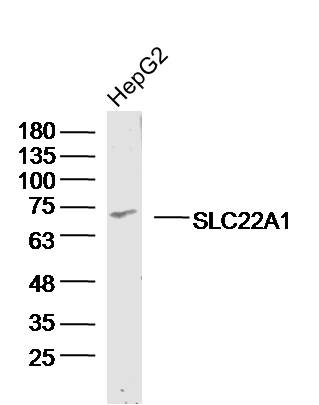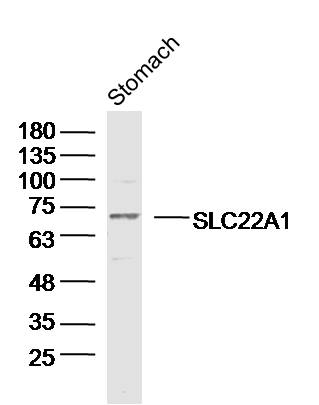SLC22A1 Rabbit pAb
SLC22A1 Rabbit pAb
- 产品详情
- 实验流程
- 背景知识
Application
| WB |
|---|---|
| Primary Accession | O08966 |
| Reactivity | Mouse |
| Host | Rabbit |
| Clonality | Polyclonal |
| Calculated MW | 61521 Da |
| Physical State | Liquid |
| Immunogen | KLH conjugated synthetic peptide derived from mouse SLC22A1 |
| Epitope Specificity | 51-150/556 |
| Isotype | IgG |
| Purity | affinity purified by Protein A |
| Buffer | Preservative: 0.02% Proclin300, Constituents: 1% BSA, 0.01M PBS, pH7.4. |
| SUBCELLULAR LOCATION | Basolateral cell membrane. |
| SIMILARITY | Belongs to the major facilitator superfamily. Organic cation transporter family. |
| Post-translational modifications | Phosphorylated. |
| Important Note | This product as supplied is intended for research use only, not for use in human, therapeutic or diagnostic applications. |
| Background Descriptions | The protein encoded by this gene is involved in the sodium-independent transport and excretion of organic anions, some of which are potentially toxic. The encoded protein is an integral membrane protein and is found mainly in the kidney and in the placenta, where it may act to prevent potentially harmful organic anions from reaching the fetus. [provided by RefSeq, Jul 2008] |
| Gene ID | 20517 |
|---|---|
| Other Names | Solute carrier family 22 member 1, Organic cation transporter 1, mOCT1, Slc22a1 {ECO:0000312|MGI:MGI:108111} |
| Target/Specificity | Widely expressed with high level in liver. Isoform 1 and isoform 2 are expressed in liver. Isoform 1, isoform 2, isoform 3 and isoform 4 are expressed in glial cell lines. |
| Dilution | WB=1:500-2000 |
| Format | 0.01M TBS(pH7.4) with 1% BSA, 0.09% (W/V) sodium azide and 50% Glyce |
| Storage | Store at -20 °C for one year. Avoid repeated freeze/thaw cycles. When reconstituted in sterile pH 7.4 0.01M PBS or diluent of antibody the antibody is stable for at least two weeks at 2-4 °C. |
| Name | Slc22a1 {ECO:0000312|MGI:MGI:108111} |
|---|---|
| Function | Electrogenic voltage-dependent transporter that mediates the transport of a variety of organic cations such as endogenous bioactive amines, cationic drugs and xenobiotics (PubMed:10216142, PubMed:11463829, PubMed:12176030, PubMed:23458604, PubMed:24961373). Functions as a pH- and Na(+)-independent, bidirectional transporter (By similarity). Cation cellular uptake or release is driven by the electrochemical potential (i.e. membrane potential and concentration gradient) and substrate selectivity (By similarity). Hydrophobicity is a major requirement for recognition in polyvalent substrates and inhibitors (PubMed:23458604). Primarily expressed in the basolateral membrane of hepatocytes and proximal tubules and involved in the uptake and disposition of cationic compounds from the blood by hepatic and renal clearance (By similarity). Most likely functions as an uptake carrier in enterocytes contributing to the intestinal elimination of organic cations from the systemic circulation (PubMed:11463829, PubMed:24961373). Transports endogenous monoamines such as N-1- methylnicotinamide (NMN), guanidine, neurotransmitters dopamine, serotonin, noradrenaline, adrenaline and histamine, and quaternary ammonium compound such as choline (PubMed:24961373, PubMed:35469921). Also transports natural polyamines such as spermidine, agmatine and putrescine at low affinity, but relatively high turnover (PubMed:23458604). Involved in the hepatic and intestinal uptake of the vitamin B1/thiamine, hence regulating hepatic lipid and energy metabolism (PubMed:24961373). Contributes to the influx and efflux of fatty acid carriers carnitines and acylcarnitines across the basolateral membrane of hepatocytes, from the liver to the systemic circulation and inversely and may be involved in regulating the systemic availability of hepatic acylcarnitines (PubMed:28942964, PubMed:34040533). Also capable of transporting non-amine endogenous compounds such as prostaglandin E2 (PGE2) and prostaglandin F2-alpha (PGF2-alpha) (By similarity). May contribute to the transport of cationic compounds in testes across the blood-testis-barrier (By similarity). Also mediates the uptake of xenobiotics tributylmethylammonium (TBuMA), quinidine, N-methyl-quinine (NMQ), N- methyl-quinidine (NMQD) N-(4,4-azo-n-pentyl)-quinuclidine (APQ), azidoprocainamide methoiodide (AMP), N-(4,4-azo-n-pentyl)-21- deoxyajmalinium (APDA) and 4-(4-(dimethylamino)styryl)-N- methylpyridinium (ASP) (PubMed:11463829). |
| Cellular Location | Basolateral cell membrane; Multi-pass membrane protein. Apical cell membrane; Multi-pass membrane protein. Lateral cell membrane {ECO:0000250|UniProtKB:O15245}; Multi-pass membrane protein. Basal cell membrane {ECO:0000250|UniProtKB:O15245}; Multi-pass membrane protein. Note=Localized to the sinusoidal/basolateral membrane of hepatocytes (PubMed:28942964) Mainly localized to the basolateral membrane of renal proximal tubular cells (By similarity). However, also identified at the apical side of proximal tubular cells (By similarity). Mainly expressed at the lateral membrane of enterocytes (By similarity). Also observed at the apical side of enterocytes (PubMed:23680637). Localized to the basal membrane of Sertoli cells (By similarity). {ECO:0000250|UniProtKB:O15245, ECO:0000250|UniProtKB:Q63089, ECO:0000269|PubMed:23680637, ECO:0000269|PubMed:28942964} |
| Tissue Location | Expressed in kidney (PubMed:11463829, PubMed:16381671, PubMed:23680637, PubMed:28942964, PubMed:8854860) Expressed in liver (PubMed:11463829, PubMed:16381671, PubMed:24961373, PubMed:28942964, PubMed:8854860). In liver, mainly expressed in the central vein (PubMed:24961373). Expressed in intestines (PubMed:11463829, PubMed:23680637, PubMed:28942964). Weakly expressed in adrenals and in lacting mammary glands (PubMed:8854860) |
Research Areas
For Research Use Only. Not For Use In Diagnostic Procedures.
Application Protocols
Provided below are standard protocols that you may find useful for product applications.
BACKGROUND
This product as supplied is intended for research use only, not for use in human, therapeutic or diagnostic applications.
终于等到您。ABCEPTA(百远生物)抗体产品。
点击下方“我要评价 ”按钮提交您的反馈信息,您的反馈和评价是我们最宝贵的财富之一,
我们将在1-3个工作日内处理您的反馈信息。
如有疑问,联系:0512-88856768 tech-china@abcepta.com.























 癌症的基本特征包括细胞增殖、血管生成、迁移、凋亡逃避机制和细胞永生等。找到癌症发生过程中这些通路的关键标记物和对应的抗体用于检测至关重要。
癌症的基本特征包括细胞增殖、血管生成、迁移、凋亡逃避机制和细胞永生等。找到癌症发生过程中这些通路的关键标记物和对应的抗体用于检测至关重要。 为您推荐一个泛素化位点预测神器——泛素化分析工具,可以为您的蛋白的泛素化位点作出预测和评分。
为您推荐一个泛素化位点预测神器——泛素化分析工具,可以为您的蛋白的泛素化位点作出预测和评分。 细胞自噬受体图形绘图工具为你的蛋白的细胞受体结合位点作出预测和评分,识别结合到自噬通路中的蛋白是非常重要的,便于让我们理解自噬在正常生理、病理过程中的作用,如发育、细胞分化、神经退化性疾病、压力条件下、感染和癌症。
细胞自噬受体图形绘图工具为你的蛋白的细胞受体结合位点作出预测和评分,识别结合到自噬通路中的蛋白是非常重要的,便于让我们理解自噬在正常生理、病理过程中的作用,如发育、细胞分化、神经退化性疾病、压力条件下、感染和癌症。







